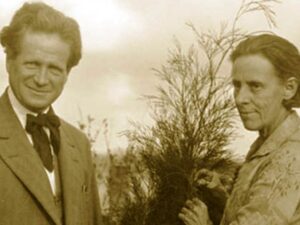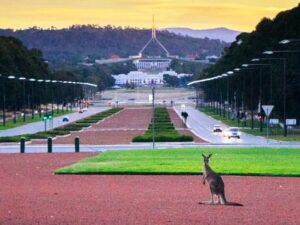» posted on Saturday, July 30th, 2022 by Linda Lou Burton
City in a Landscape
 Originally Published July 29, 2020 by Linda Lou Burton posting about Canberra, Australia from Little Rock, Arkansas – My last post was about a beautiful building; this one focuses on the beautiful city in which that building sits, Canberra, Australia. It takes a lot of thinking, planning, and arguing for “what is best” when building a city. Washington, DC is a good example of that, beginning with George Washington’s appointment of Pierre Charles L’Enfant to design a capital city, and what happened over the years after that. Here is Canberra’s story of Charles Scrivener, Walter Burley Griffin, Marion Mahoney Griffin, and Charles Weston, and what happened over the years.
Originally Published July 29, 2020 by Linda Lou Burton posting about Canberra, Australia from Little Rock, Arkansas – My last post was about a beautiful building; this one focuses on the beautiful city in which that building sits, Canberra, Australia. It takes a lot of thinking, planning, and arguing for “what is best” when building a city. Washington, DC is a good example of that, beginning with George Washington’s appointment of Pierre Charles L’Enfant to design a capital city, and what happened over the years after that. Here is Canberra’s story of Charles Scrivener, Walter Burley Griffin, Marion Mahoney Griffin, and Charles Weston, and what happened over the years.
About Charles Scrivener
 Charles Scrivener was the New South Wales Government Surveyor back in 1908 when the Canberra area was chosen by Parliament as a site for Australia’s future capital city. The Canberra valley, set in an amphitheatre of hills, was chosen because it had “a bracing climate, good water supply, and natural beauty.” Scrivener’s task was to explore the area and prepare a contour survey, which he did; he also suggested four possible points along the Molonglo River where dams could be constructed to create ornamental waters. Fast forward to 1964. Scrivener Dam was inaugurated, creating Lake Burley Griffin, an ornamental body of water in the center of Canberra.
Charles Scrivener was the New South Wales Government Surveyor back in 1908 when the Canberra area was chosen by Parliament as a site for Australia’s future capital city. The Canberra valley, set in an amphitheatre of hills, was chosen because it had “a bracing climate, good water supply, and natural beauty.” Scrivener’s task was to explore the area and prepare a contour survey, which he did; he also suggested four possible points along the Molonglo River where dams could be constructed to create ornamental waters. Fast forward to 1964. Scrivener Dam was inaugurated, creating Lake Burley Griffin, an ornamental body of water in the center of Canberra.
About Walter Burley Griffin and Marion Mahoney Griffin
 Walter Griffin was born in Chicago, studied architecture at the University of Illinois, and for a time worked with Frank Lloyd Wright. He eventually set up his own practice and from 1899 to 1914, created more than 130 designs for buildings, urban plans and landscapes in Illinois, Iowa, Michigan and Wisconsin. In 1911 he married Marion Mahony, an MIT graduate in architecture. They were on their honeymoon when they heard of the international competition held by the Australian Commonwealth Government to produce a design for its new capital city. They worked feverishly to prepare their entry; Marion presented Walter’s designs in a series of vivid drawings showing a city nestled into hills and valleys. In May 1912 their design was selected as the winner out of 137 entries.
Walter Griffin was born in Chicago, studied architecture at the University of Illinois, and for a time worked with Frank Lloyd Wright. He eventually set up his own practice and from 1899 to 1914, created more than 130 designs for buildings, urban plans and landscapes in Illinois, Iowa, Michigan and Wisconsin. In 1911 he married Marion Mahony, an MIT graduate in architecture. They were on their honeymoon when they heard of the international competition held by the Australian Commonwealth Government to produce a design for its new capital city. They worked feverishly to prepare their entry; Marion presented Walter’s designs in a series of vivid drawings showing a city nestled into hills and valleys. In May 1912 their design was selected as the winner out of 137 entries.
 Walter’s winning design showed a chain of lakes along the Molonglo Valley and a triangular framework for a central national area laid out along major vistas. Marion’s drawings showed a new type of Australian town plan, where buildings, roads and gardens could work together to make a picturesque and livable city. The geometric pattern, developed from the topography of the land, had long tree-lined avenues and boulevards and incorporated significant areas of natural vegetation.
Walter’s winning design showed a chain of lakes along the Molonglo Valley and a triangular framework for a central national area laid out along major vistas. Marion’s drawings showed a new type of Australian town plan, where buildings, roads and gardens could work together to make a picturesque and livable city. The geometric pattern, developed from the topography of the land, had long tree-lined avenues and boulevards and incorporated significant areas of natural vegetation.
Griffin was appointed Federal Capital Director of Design and Construction in 1913, and moved to Australia to supervise the detailed planning of his modern city. But lack of money, the intervention of the First World War, and bureaucratic obstacles made it difficult to realize his plan. Many of his main avenues and parks were laid out at that time, but due to differences with the administration and his own uncompromising vision, Griffin left Canberra at the end of 1920 to work elsewhere in Australia.
In 1924 the government gazetted the Griffins plan for Canberra so that no changes could be made without the approval of Parliament. This protection ensured that the plan for the city remained essentially as Griffin intended it to be — a logical expression of the site. The strength of Griffin’s design is its adaptability to grow and change.
Griffin was largely under-appreciated during his time in Australia, but recognition of his work has steadily grown. In 1964, when Canberra’s central lake was filled by the construction of Scrivener Dam, it was named Lake Burley Griffinr.
About Charles Weston
Charles Weston was an English-born horticulturist who pioneered the greening of the area and its surrounding hills. European settlement after the 1820s had a significant impact on the site; of principal concern was the destruction of tree cover on the hills and the consequent degradation of the shallow soils; there was widespread water and wind erosion. Weston faced a challenging task; an added problem was the conflict between Griffin and Weston over choices of suitable tree species. In all, between 1913 and 1926, Weston was responsible for the planting of two million trees and shrubs.
When Weston arrived in 1913, he assessed the suitability of a wide range of exotic and indigenous trees and shrubs for the site and devised the best methods of planting. He established an arboretum to test the growth of trees; by 1920 almost 45,000 trees had been planted there; it is still in use today. He next turned his attention to rehabilitating degraded hill areas. Between 1915 and 1924 he treated over 2,500 acres of public land. He took the first steps in the conservation of the ACT’s rural landscape. He laid down a set of conditions to achieve control over the lopping of vegetation for fodder and the killing of trees by ring-barking. In addition, he issued free trees to landholders.
 He created a special landscape character for the streets, avenues and parklands of the emerging city, achieving strong seasonal color effects and protection from the bitter cold and hot dusty winds.
He created a special landscape character for the streets, avenues and parklands of the emerging city, achieving strong seasonal color effects and protection from the bitter cold and hot dusty winds.
The legacy of Charles Scrivener, Walter Burley Griffin and Marion Mahoney Griffin, and Charles Weston is the creation of Canberra as a city in the landscape.
As of June 2019 the population of this city in a landscape named Canberra was 426,704. Located 93 miles inland from the coast near the Brindabella Ranges, it covers an area of 314 square miles at an elevation of approximately 1,900 feet; the highest point is Mount Majura at 2,913 feet.
It’s a really pretty place, you should visit.
 Visit Canberra https://visitcanberra.com.au/
Visit Canberra https://visitcanberra.com.au/
